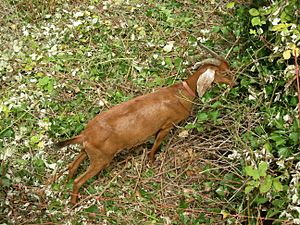Spanish goat facts for kids

The Spanish goat is a special type of goat. People also call it the brush goat or scrub goat. These goats first came from Spain, traveling through Mexico to the USA. Today, you can find them widely across the United States. They are mainly raised for their meat and for clearing unwanted plants.
In different parts of the US, they have different names. For example, in Florida, they are called "wood" goats. In North and South Carolina, they are known as "brush" or "briar" goats. People in Virginia might call them "hill" goats. Until recently, these goats were mostly used to clear brush and other plants from pastures. However, in the 1980s, another type of goat, the Boer goat, became more popular for meat.
History of Spanish Goats
Around the 1500s, Spanish explorers brought these goats from their home country. They took them to the Caribbean Islands and areas that are now the United States and Mexico. Some of these original goats still exist in Spain. But many of them survive through the goats brought to the "New World."
Spanish goats are very tough animals. They can live well even in difficult places. Pure Spanish goats have been mixed with other goat breeds. This was done to produce cashmere wool or more meat. Most mixed-breed goats show "superb hybrid vigor." This means they are stronger and healthier. However, because of all this mixing, pure Spanish goats are now rare. They are on a special list called the American Livestock Breeds Conservancy watch list. This list helps protect animals that are in danger.
What Makes Spanish Goats Special?
Spanish goats can have babies at different times of the year. This is not common for all goats. They are also great at grazing in large open areas. This is because they have small udders and teats. These goats are very strong and healthy. They can live and grow well even when conditions are tough. They do not need a lot of special care.
The term "Spanish goats" can mean different things. It can mean goats that are purely from Spain. But it can also mean a mix of all kinds of goats brought to an area. Some "Spanish" herds clearly have genes from dairy goats or Angora goats. However, people never really tried to use these goats for milk or mohair wool.
Recently, more and more people want goat meat. This has made researchers look closely at Spanish goats. They want to see how good they are for meat production. Spanish goats have shown they are very hardy. They also need less care than other meat breeds.
Some Spanish goat farmers in Texas have been working hard. They have been choosing goats to breed that produce more meat. Information from these farmers shows something interesting. These "selected" Spanish goats seem to be much better at producing meat. They are better than the regular Spanish goats used mainly for clearing land.
Protecting Spanish Goats
In the 1990s, Boer goats came to the United States from South Africa. Many farmers then started raising Boer goats instead of Spanish goats. This caused the number of Spanish goats to drop a lot. In 2009, there were only about 8,500 purebred Spanish goats in the whole country.
Now, the American Livestock Breeds Conservancy sees them as important to protect. In 2007, the Spanish Goat Association was created. Its goal is to help save this breed.
Today, people are working to find different groups of purebred Spanish goats. This work has helped describe the different family lines. It also helps create a network of breeders. The ALBC is still finding groups of Spanish goats. They are trying to preserve these special lines. Recently, they worked to save a group found on an island off South Carolina. This group is one of only two known in the Southeast region.

